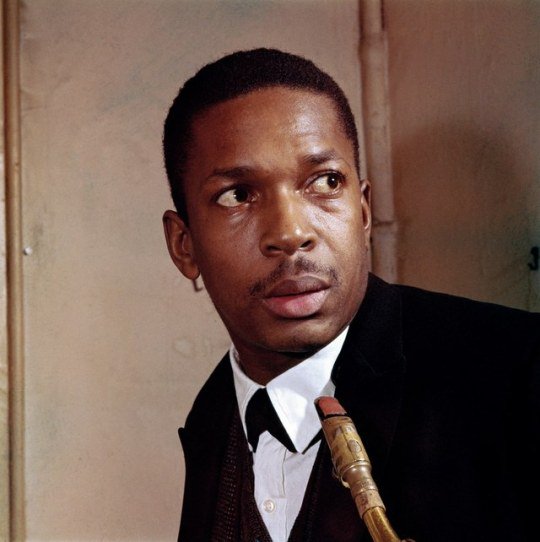John Coltrane on his spiritual awakening, miles davis, music as a reflection of the universe, and his approach to soloing.

A brief overview of John Coltrane before delving into his own words:
| Who (Identity) | John William Coltrane, an American jazz saxophonist and composer, recognized as one of the most influential jazz musicians and a pivotal figure in the history of jazz music. |
| What (Contributions) | Coltrane is celebrated for his innovative contributions to jazz, including the exploration of modal jazz, hard bop, and free jazz. He is known for albums like “A Love Supreme,” “Giant Steps,” and “Blue Train.” His work pushed the boundaries of jazz and influenced a wide range of music genres. |
| When (Period of Influence) | Active primarily in the 1950s and 1960s, Coltrane’s career was influential in shaping the direction of jazz music during and beyond his lifetime. |
| Where (Geographic Focus) | Born in Hamlet, North Carolina, USA, Coltrane was primarily active in the United States, particularly influential in the jazz scenes of cities like Philadelphia and New York. |
| Why (Artistic Philosophy) | Coltrane’s music was driven by a deep spiritual quest and a relentless pursuit of improvisational and compositional innovation. He aimed to express his spiritual experiences through music, often seeking transcendence and enlightenment in his compositions. |
| How (Technique and Style) | Known for his powerful, emotive saxophone playing, Coltrane’s style evolved from hard bop to modal jazz and ultimately to free jazz. His approach was characterized by complex chord progressions, innovative modal explorations, and rapid, cascading runs known as “Coltrane changes.” |
This post is a collection of selected quotes and excerpts from secondary sources used for educational purposes, with citations found at the end of the article.
What Is Music?
Music is a reflection of the universe, like having life in miniature. You just take a situation in life or an emotion you know and put it into music. You take a scene you’ve seen, for instance, and put it to music. 1
Music is an instrument. It can create the initial thought pattern that can create a change in the thinking of the people. 2
Favourite Books
- The Gospel of Sri Ramakrishna
- Bhagavad Gita
- Autobiography of a Yogi
He also explored Hinduism, Jiddu Krishnamurti, African history, the philosophical teachings of Plato and Aristotle. 3
Uplifting People Through Music
I’d like to point out to people the divine in a musical language that transcends words. I want to speak to their souls.
During the year 1957, I experienced, by the grace of God, a spiritual awakening which was to lead me to a richer, fuller, more productive life. At that time, in gratitude, I humbly asked to be given the means and privilege to make others happy through music. 4
Once you become aware of this force for unity in life, you can’t ever forget it. It becomes part of everything you do. In that respect, this is an extension of A Love Supreme since my conception of that force keeps changing shape.
My goal in meditating on this through music, however, remains the same. And that is to uplift people, as much as I can. To inspire them to realize more and more of their capacities for living meaningful lives. Because there certainly is meaning to life. 5
I mean I want to be a force for real good. In other words, I know that there are bad forces. I know that there are forces out here that bring suffering to others and misery to the world, but I want to be the opposite force. I want to be the force which is truly for good. 2

Miles Davis
I found Miles in the midst of another stage of his musical development [In 1958]. There was one time in his past that he devoted to multi-chorded structures. He was interested in chords for their own sake. But now it seemed that he was moving in the opposite direction to the use of fewer and fewer chord changes in songs. He used tunes with free-flowing lines and chordal direction. This approach allowed the soloist the choice of playing chordally (vertically) or melodically (horizontally).
In fact, due to the direct and free-flowing lines in his music, I found it easy to apply the harmonic ideas that I had. I could stack up chords — say, on a C7, I sometimes superimposed an Eb7, up to an F#7, down to an F. That way I could play three chords on one. But on the other hand, if I wanted to, I could play melodically. Miles’ music gave me plenty of freedom. It’s a beautiful approach. 6


Sponsored: Canvas wall art paintings of nature and the cosmos.
Testing Different Ways of Playing Music
About this time [1958], I was trying for a sweeping sound. I started experimenting because I was striving for more individual development. I even tried long, rapid lines that Ira Gitler termed “sheets of sound” at the time. But actually, I was beginning to apply the three-on-one chord approach, and at that time the tendency was to play the entire scale of each chord. Therefore, they were usually played fast and sometimes sounded like glisses [glissandos – a glide from one pitch to another].
I found there were a certain number of chord progressions to play in a given time, and sometimes what I played didn’t work out in eighth notes. 16th notes, or triplets. I had to put the notes in uneven groups like fives and sevens in order to get them all in.
I thought in groups of notes, not of one note at a time. I tried to place these groups on the accents and emphasize the strong beats — maybe on 2 here and on 4 over at the end. I would set up the line and drop groups of notes — a long line with accents dropped as I moved along. Sometimes what I was doing clashed harmonically with the piano — especially if the pianist wasn’t familiar with what I was doing — so a lot of times I just strolled with bass and drums.
I haven’t completely abandoned this approach, but it wasn’t broad enough. I’m trying to play these progressions in a more flexible manner now. 6
Music Should Be Felt And Not Understood
I never even thought about whether or not the listener understands what I’m doing… the emotional reaction is all that matters. As long as there’s some feeling of communication, it isn’t necessary that it be understood.

Influences
I’ve been listening to jazzmen, especially saxophonists, since the time of the early Count Basie records, which featured Lester Young. Pres was my first real influence, but the first horn I got was an alto, not a tenor. I wanted a tenor, but some friends of my mother advised her to buy me an alto because it was a smaller horn and easier for a youngster to handle. This was 1943.
Johnny Hodges became my first main influence on alto, and he still kills me. I stayed with alto through 1947, and by then I’d come under the influence of Charlie Parker. The first time I heard Bird play, it hit me right between the eyes. Before I switched from alto in that year, it had been strictly a Bird thing with me, but when I bought a tenor to go with Eddie Vinson’s band, a wider area of listening opened up for me.I found I was able to be more varied in my musical interests. On alto, Bird had been my whole influence, but on tenor I found there was no one man whose ideas were so dominant as Charlie’s were on alto. Therefore, I drew from all the men I heard during this period. I have listened to about all the good tenor men, beginning with Lester, and believe me, I’ve picked up something from them all, including several who have never recorded.
The reason I liked Lester so was that I could feel that line, that simplicity. My phrasing was very much in Lester’s vein at this time.
I found out about Coleman Hawkins after I learned of Lester. There were a lot of things that Hawkins was doing that I knew I’d have to learn somewhere along the line. I felt the same way about Ben Webster. There were many things that people like Hawk, Ben, and Tab Smith were doing in the ’40s that I didn’t understand but that I felt emotionally.
The first time I heard Hawk, I was fascinated by his arpeggios and the way he played. I got a copy of his Body and Soul and listened real hard to what he was doing. And even though I dug Pres, as I grew musically, I appreciated Hawk more and more.
As far as musical influences, aside from saxophonists, are concerned, I think I was first awakened to musical exploration by Dizzy Gillespie and Bird. It was through their work that I began to learn about musical structures and the more theoretical aspects of music.
Also, I had met Jimmy Heath, who, besides being a wonderful saxophonist, understood a lot about musical construction. I joined his group in Philadelphia in 1948. We were very much alike in our feeling, phrasing, and a whole lot of ways. Our musical appetites were the same. We used to practice together, and he would write out some of the things we were interested in. We would take things from records and digest them. In this way we learned about the techniques being used by writers and arrangers.
Another friend and I learned together in Philly — Calvin Massey, a trumpeter and composer who now lives in Brooklyn. His musical ideas and mine often run parallel, and we’ve collaborated quite often. We helped each other advance musically by exchanging knowledge and ideas.I first met Miles Davis about 1947 and played a few jobs with him and Sonny Rollins at the Audubon ballroom in Manhattan. During this period he was coming into his own, and I could see him extending the boundaries of jazz even further. I felt I wanted to work with him. But for the time being, we went our separate ways.
I went with Dizzy’s big band in 1949. I stayed with Diz through the breakup of the big band and played in the small group he organized later.
Afterwards, I went with Earl Bostic, who I consider a very gifted musician. He showed me a lot of things on my horn. He has fabulous technical facilities on his instrument and knows many a trick.
Then I worked with one of my first loves, Johnny Hodges. I really enjoyed that job. I liked every tune in the book. Nothing was superficial. It all had meaning, and it all swung. And the confidence with which Rabbit plays! I wish I could play with the confidence that he does.
But besides enjoying my stay with Johnny musically, I also enjoyed it because I was getting firsthand information about things that happened way before my time. I’m very interested in the past, and even though there’s a lot I don’t know about it, I intend to go back and find out. I’m back to Sidney Bechet already.
Take Art Tatum, for instance. When I was coming up, the musicians I ran around with were listening to Bud Powell, and I didn’t listen too much to Tatum. That is, until one night I happened to run into him in Cleveland. There were Art and Slam Stewart and Oscar Peterson and Ray Brown at a private session in some lady’s attic. They played from 2:30 in the morning to 8:30 — just whatever they felt like playing. I’ve never heard so much music. 6
Approach To Soloing
From a technical viewpoint, I have certain things I’d like to present in my solos. To do this, I have to get the right material. It has to swing, and it has to be varied. (I’m inclined not to be too varied.) I want it to cover as many forms of music as I can put into a jazz context and play on my instruments.
I like Eastern music; Yusef Lateef has been using this in his playing for some time. And Ornette Coleman sometimes plays music with a Spanish content as well as other exotic-flavored music. In these approaches there’s something I can draw on and use in the way I like to play. 6

Studying Music
I’ve been devoting quite a bit of my time to harmonic studies on my own, in libraries and places like that. I’ve found you’ve got to look back at the old things and see them in a new light. I’m not finished with these studies because I haven’t assimilated everything into my playing. I want to progress, but I don’t want to go so far out that I can’t see what others are doing.
I want to broaden my outlook in order to come out with a fuller means of expression. I want to be more flexible where rhythm is concerned. I feel I have to study rhythm some more. I haven’t experimented too much with time; most of my experimenting has been in a harmonic form. I put time and rhythms to one side, in the past.I’ve got to keep experimenting. I feel that I’m just beginning. I have part of what I’m looking for in my grasp but not all.
I’m very happy devoting all my time to music, and I’m glad to be one of the many who are striving for fuller development as musicians. Considering the great heritage in music that we have, the work of giants of the past, the present, and the promise of those who are to come, I feel that we have every reason to face the future optimistically. 6
Thelonious Monk
Working with Monk brought me close to a musical architect of the highest order. I felt I learned from him in every way — through the senses, theoretically, technically. I would talk to Monk about musical problems, and he would sit at the piano and show me the answers just by playing them. I could watch him play and find out the things I wanted to know. Also, I could see a lot of things that I didn’t know about at all.
Monk was one of the first to show me how to make two or three notes at one time on tenor. It’s done by false fingering and adjusting your lip. If everything goes right, you can get triads. Monk just looked at my horn and “felt” the mechanics of what had to be done to get this effect.
I think Monk is one of the true greats of all time. He’s a real musical thinker — there’re not many like him. I feel myself fortunate to have had the opportunity to work with him. If a guy needs a little spark, a boost, he can just be around Monk, and Monk will give it to him. 6
The Musicians Mission
It’s more than beauty that I feel in music—that I think musicians feel in music. What we know we feel we’d like to convey to the listener. We hope that this can be shared by all. I think, basically, that’s about what it is we’re trying to do. We never talked about just what we were trying to do. If you ask me that question, I might say this today and tomorrow say something entirely different, because there are many things to do in music.
But, overall, I think the main thing a musician would like to do is to give a picture to the listener of the many wonderful things he knows of and senses in the universe. That’s what music is to me—it’s just another way of saying this is a big, beautiful universe we live in, that’s been given to us, and here’s an example of just how magnificent and encompassing it is. That’s what I would like to do. I think that’s one of the greatest things you can do in life, and we all try to do it in some way. The musician’s is through his music. 1
All a musician can do is to get closer to the sources of nature, and so feel that he is in communion with the natural laws. Then he can feel that he is interpreting them to the best of his ability, and can try to convey that to others. 7
Sunday Museletter (Free)
Ignite your creativity with hand-picked weekly recommendations in music, film, books, and art — sent straight to your inbox every Sunday.
Next up: Ingmar Bergman on Intuition.
References
- John Coltrane and Eric Dolphy Answer the Jazz Critics, April 12, 1962, Downbeat
- Interview with Frank Kofski, August 18, 1966, Pacifica Radio Archives
- The Dawn of Indian Music in the West, Peter Lavezzoli
- ‘A Love Supreme’ Liner Notes
- ‘Meditations’ Liner Notes
- John Coltrane in collaboration with Don DeMicheal, September 29, 1960, Downbeat
- Wilmer Interview with John Coltrane, 1962 in Woideck p108-9

 1 painting, album, film, and book recommendation every week.
1 painting, album, film, and book recommendation every week.